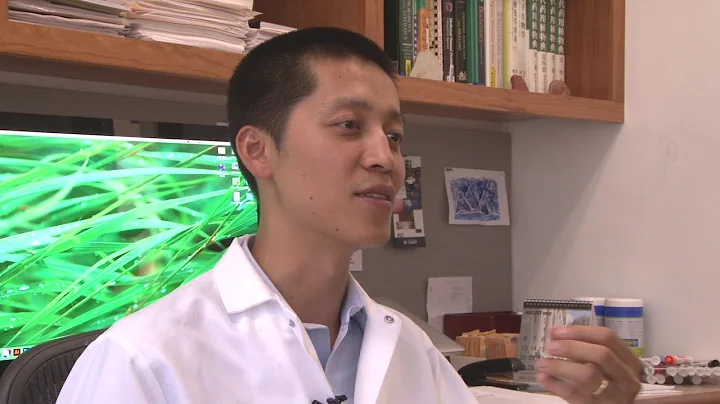
Picture source @Visual China
Article | Same as freehand, author丨Huang Yi, editor丨Yu Jing
China's innovative drug research and development has reached today, and Fast follow in the traditional context is basically no longer enthusiastic. Despite this, at least so far, most Biotech companies, including investment institutions, do not seem to have collectively turned to pursue truly innovative targets - whether these targets are called First in Class or not.
Personally, I don’t really like classifying targets according to Fast follow and First in Class - the complex real world is obviously not so black and white. Whether a target will be considered by Biotech companies and investors, even the most refined thinking dimensions, must include at least two items: first, whether the R&D risk is high; second, whether the level of competition is high, using the currently popular The saying is "roll or not". The two dimensions of
are basically negatively correlated: targets with low R&D risk must be "rolled" badly, while targets with "no roll" have higher R&D risks. The first half of the sentence was originally about generic drugs, but later it became about first generic drugs, and now Fast follow is the same. At first glance, it seems that there are not many good opportunities to choose from for innovative drug research and development. But in fact, wealth can be gained through risk. Which business in the world is not like this? Although it seems that there is no danger of being caught, many real opportunities can only be discovered and cultivated by constantly wandering between the two extremes.
The target selection of innovative drugs follows a similar logic. Since the low-risk targets are now a little "cannot be rolled", we might as well change the direction and look at those targets that are definitely "not rolled". Although such a shift will inevitably increase R&D risks, it is not necessarily an unsolvable dead end. In fact, in the R&D process of relatively high R&D risk targets, many mature experiences can indeed help reduce risks as much as possible and improve R&D certainty. For example, in the equally high-risk extreme sports of and , veteran drivers are obviously much safer than rookies.
01 Choose a non-crowded track with stronger demand.
The so-called demand is stronger. In short, it means that the target population is large and there is a lack of effective treatment methods.
Let’s take oncology drugs as an example. The R&D competition pattern among different cancer types is actually very different. Whether it is statistical data from different channels or intuitive experience in the industry, we can probably find that the competition in the R&D of new drugs for hematomas and lymphomas is far more intense than for solid tumors. (especially considering that there is also a piece of CAR-T).
Among the numerous and complicated dozens of solid tumors, the "cold and hot" are also uneven. R&D resources are squeezed into a few limited cancer types such as lung cancer, breast cancer , and others such as gastric cancer (not counting HER2 and Claudin). 18.2), esophageal cancer , ovarian cancer, pancreatic cancer , these are relatively "quiet", especially in China. If you look through the NCCN or CSCO guidelines, you will find that many new drugs that are widely discussed every day are squeezed into the bottom line of a limited number of tumor types. For a large number of cancer types, there is almost no other more effective drug after chemotherapy. s method.

Overview of types of drugs under development in China for different types of cancer Data source: Li G, et al. Nat Rev Drug Discov. 2021 Jan;20(1):15-16.
In fact, such an unbalanced layout is exactly It is an opportunity for new targets. The "research and development" of many cancer types has been stagnant, seemingly because research and development are too difficult. But in fact, whether it is patients, clinicians or regulatory agencies, they all hope that the industry can bring more treatment options for these indications. Therefore, in terms of clinical enrollment, regulatory requirements and even subsequent commercialization thresholds, they are often much looser than those crowded cancer types.
For truly innovative targets, uncongested cancer types should actually be a better choice. At least you can avoid PKing with those hot and popular drugs. You don’t have to worry about any “volume” risks and just concentrate on dealing with R&D risks—— This is closer to the essence of innovation. Especially for domestic companies, gastrointestinal tumors such as gastric cancer and esophageal cancer have been ignored by European and American companies for many years, but they are in clear demand of the Chinese population. In fact, the opportunities are very large.
From a more macro perspective, the less mature the track, the easier it is to have the opportunity to "overtake in corners", which is analogous to China's Internet and new energy automobile industries. This logic also applies to indication selection. If Chinese Biotech really has the opportunity to produce world-class new drugs in the future, I think there is a greater chance that it will appear in those cancer types that are recognized to have strong R&D needs but are rarely touched by European and American companies.
02 In-depth exploration of the biological mechanism of disease
Choosing a direction is only the first step. The more important thing is to judge the chance of going forward, which requires a deep enough understanding of the biological mechanism of the target disease. For some pharmaceutical companies, many cancers are afraid to be touched because they are indeed frightened by the "unknown" risks.
What is the risk of using an innovative target as a drug development target? Biological mechanisms at different levels need to be explored. In this process, academia and industry have their own positions and strengths.
It should be common sense now that finding a protein with high expression in tumors can be used as a drug target. It is probably not difficult to understand the upstream and downstream signaling pathways of the target and its position in the entire network (whether it is a hub or redundancy). For any potential target, a lot of relevant information can now be found. Up to this point, it is still just basic scientific research work in academia. For companies, it probably means searching and reading literature. So is this enough?
is not. For innovative targets, the next step is key. These conclusions from basic research, such as signaling pathways, protein interactions, etc., are often based on classic research models, including cell lines, Drosophila , C. elegans , mouse strains, etc. Biotech is engaged in the research and development of innovative drugs, focusing on various specific diseases and patient groups. Basic research has discovered that these signals that may serve as targets are still true signals in the target disease? This process is left more to companies interested in a specific target to explore on their own.
These all require scarce models that are closer to the human body, such as patient tissue samples and humanized mice, to determine whether relevant findings are reproducible, whether specific diseases are relevant, whether specific populations are sensitive or highly expressed, and which mechanism-based drug combinations are more effective. etc. to verify. This is one of the main tasks of our Nanjing Translational Medicine Laboratory (Yingshi Biotech), and it is also a solid foundation for us to dare to explore innovative targets. In the past two years, some of our research has been published in high-level international journals, which is also a good proof of our innovation. Fast follow, which is a mature target of
, basically does not require such exploration and research. It is easy and risk-free. The price is that anyone can do it and start "rolling". Innovative targets are naturally “non-volatile”, but in order to be truly stable, these unique understandings of diseases based on in-house research are essential. Without this understanding, you cannot determine the true and reliable information from the numerous public information, let alone connect the target information with the real disease information. Even for targets that have entered clinical trials in Europe and the United States, development strategies can only follow what others say. When treating hematomas abroad, you can only treat hematomas. You don’t even dare to try lymphomas, and you don’t even dare to think about more valuable solid tumors.
03 Have the ability and attitude of true clinical research
For the research of truly innovative targets, clinical trials are not only Development, but also Research, including many explorations of the unknown.
Many preclinical drug discovery scientists, including innovative drug investors, often have some misunderstandings about clinical research, or are limited by the inherent concepts of the fast follow era, paying more attention to the advantageous parameters shown in various preclinical comparisons of candidate molecules. Many times it is believed that once the candidate molecule is determined, the fate is basically determined. Regarding follow-up clinical research, although I realize that the investment is high and difficult, I feel that this process is just development and verification, and whether it is good or not is just a gamble. These perceptions are actually inaccurate. The clinical research on the
innovative target is the first time that the target is manipulated at the human level. The various information feedback obtained, including safety, effectiveness, etc., will most likely deviate from expectations.Are these deviations within controllable limits? Is it a problem with the target itself, a problem with the molecule, or a problem with the selection of patient groups or indications? Is there some hypothetical way to adjust toxicity or safety back to the desired trajectory? How should these hypotheses be tested preclinically and then returned to clinical adjustments based on the results? ...and so on.
In addition to these issues based on science itself, there are also issues related to medical practice in different countries corresponding to the clinical positioning of new drugs for target indications. This point has been discussed a lot before and after the FDA's ODAC meeting on Innovent at the beginning of this year, so we will not discuss it here. Expand more.
These challenges all show that clinical research on innovative targets is not just a step-by-step verification process. Biotech companies need to truly carry out clinical research with a research attitude. Subtle differences at every step, from protocol design to clinical operations, can have a huge impact on progress and final outcomes. This also highlights the clinical research capabilities of a Biotech company and the importance of truly grasping the drug development process of innovative targets, which is likely to exceed the understanding formed in the past fast follow era. This ability is reflected in many aspects, including the founder’s judgment and understanding of clinical research, the experience and norms of the clinical execution team, as well as the cooperation and collaboration of preclinical research, etc.
The same is true for our own clinical research. In the development of IN10018, we adopted a targeted combination strategy for different types of cancer, which was based on program design and targeted model verification based on the study of disease biological mechanisms. Including development in China and the United States, different cancer types are selected and different clinical plans are designed, instead of simply expanding the same plan to different cancer types or even different countries. This kind of "prescribing the right medicine" is also the basis for us to have a higher probability of clinical success.
In the past ten years, when domestic investment institutions looked at innovative drugs, most of them focused on various elements of the project, from preclinical data to team experience. For clinical development, they always thought of spending a lot of money to dig up CMOs as soon as the car arrived. It has brought about various chaos in the country including "jellyfish CMO". If you want to explore projects that can truly tackle innovative targets in the future, the clinical research experience of the founding team, or at least the clinical research thinking, should be the key evaluation factor.
04 In-depth exploration of human research data on relevant targets
Drug research and development will ultimately return to human application, and the human body-related data and research experience of all innovative targets need to be deeply explored. Even the negative data is an attempt to perturb the target target in an unknown human system. All feedback is a rare guide for subsequent improvement and development. The development of innovative targets is rarely smooth sailing, and there are many new targets that have failed in their first human trials. Even among the most popular targets today, many were on the verge of being abandoned.
, such as CDK4/6, has been continuously tried by the industry since the mid-1990s, and has been in clinical use for many years because of its safety and target selectivity. Another example is Palbociclib, which made a fortune many years later. After it was synthesized in 2001, its research and development stumbled. In 2003, Pfizer cut off the Ann Arbor R&D center, and even the internal supporting scientific research team was gone; in 2004, Phase was finally launched. I, an all comer trial design, saw almost no clinical effect. This situation is almost a death sentence within Pfizer.
Fortunately, this target has not been abandoned in the research field, and its many characteristics in tumor regulation have been continuously discovered. Many research teams, including Slamon, have conducted a lot of research on breast cancer and other disease models, and finally Pfizer was impressed to redesign and advance the subsequent development of Palbociclib, and saw amazing efficacy in the Phase II study of ER-positive breast cancer, which ultimately led to the creation of this "blockbuster" drug.
The same is true for the FAK target that we are rapidly advancing, which can be seen from the changes in the popularity of Review articles in PubMed searches.FAK first began to attract attention around 2010, and the number of Reviews increased rapidly; by 2015, several Phase I data were lower than expected, and the number of Reviews decreased significantly for three consecutive years; after 2019, the academic and industrial circles also Including us, we have made a series of important discoveries about this target, especially several very beautiful clinical data have been disclosed one after another. The popularity of this target has picked up again, and even many PROTAC companies are eager to try it.

FAK Related Review Quantity trend over the years Source: PubMed
It can be seen that the judgment of innovation targets should not be based on temporary success or failure. Can we, on the basis of past research, especially human research, conduct in-depth exploration of the biological mechanisms of the targets, gain a unique understanding of these innovative targets, and further design subsequent development paths in accordance with the scientific laws of drug research and development? Unearthing the real value and finding the right direction to continue development are the keys to ultimate success.
Even if MNC presses the pause button on the targets, including targets that were stopped after Phase I clinical trials, it may not be possible to produce good projects. Loxo Oncology's blockbuster oral TRK inhibitor Larotrectinib was first developed by Array BioPharma. Horizon Therapeutics' IGF-1R monoclonal antibody drug Teprotumumab was first developed by Genmab and Roche as a popular anti-tumor target drug. Biohaven, the star of the recent tens-billion acquisition, its flagship product, Rimegepant, was originally an early clinical study completed by BMS. This is also true for some of our own project introduction strategies, which are obviously different from the License in model that was popular in China in previous years.
This is probably similar to how capable families can turn "universal schools" into "school district housing", and capable companies can turn unpopular targets into popular targets. The premise is that you must truly create value through innovative research.
05 Conclusion
Not long ago, an article about the resignation speech of John Maraganore, the founding CEO of Alnylam, became popular all over the Internet. Investigating the reason, I think the inspirational story of Alnylam suffering through adversity for many years and finally surviving the clouds has deeply resonated with the industry. In recent years, China’s innovative drugs have experienced ups and downs like a roller coaster, both in terms of industry environment and capital environment. Despite the twists and turns, there is no doubt that progress has been made in the general direction.
Today, the cold winter is coming again, and the entire industry is beginning to come under pressure again. A period of shock and elimination is inevitable. But only in this way can we bid farewell to the "involution" Fast Follow era and enter the next new era. More R&D that is truly targeted at innovative targets is attracting more and more attention. In addition to aiming in this general direction, how to reduce risks during the R&D process and move forward stably will inevitably be considered by more and more practitioners.
Finally, I would like to quote a sentence that I like very much from the aforementioned popular article, and share it with all my colleagues who are spending the winter together: "Falling stories are suitable for competing for resources as quickly as possible during the bubble period, while down-to-earth drug assets are suitable for the depression cycle." lifesaver.”

















